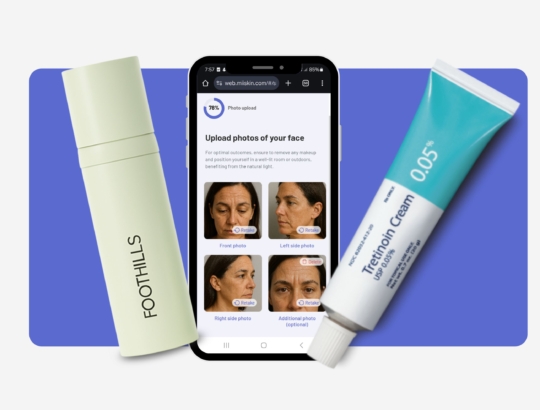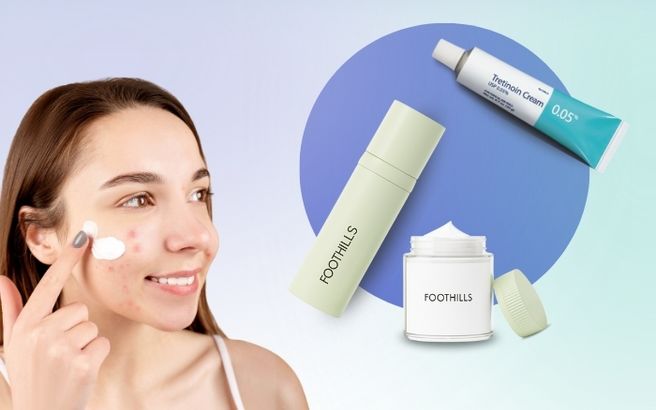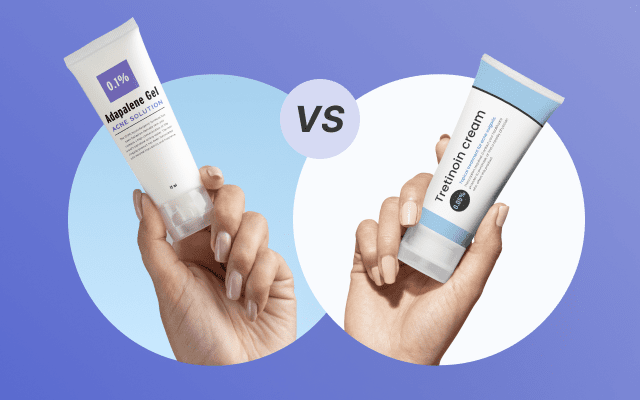Can you use tretinoin for rosacea or sensitive skin?
Dr. Anna Chacon, board-certified dermatologist explains how you can use tretinoin for anti-aging and dark spots, even if you have rosacea or sensitive skin.
Table of Content:
What is rosacea? | Can you use tretinoin to treat rosacea? | Best creams for rosacea | How to get a prescription? | If you have rosacea can you use tretinoin? | Can you use tretinoin if you have sensitive skin? | How to use tretinoin with rosacea or sensitive skin?
Our commitment to producing high-quality content:
The information presented in this article is based on scientific research and the professional advice of our Content Medical Reviewers, who are experts in the field of Dermatology. How we write our content →
What is rosacea?
Rosacea is a chronic skin condition that predominantly targets the facial area. It manifests through symptoms such as facial redness, flushing, noticeable blood vessels, tiny red bumps known as papules, small lesions filled with pus referred to as pustules, and occasionally, skin thickening, particularly around the nose area.
Individuals with rosacea often report heightened skin sensitivity, which can manifest as a tendency to react to certain skincare products and environmental factors more easily than individuals without the condition. This increased sensitivity may result in burning, stinging, itching, or a sensation of tightness when skin comes into contact with irritants or triggers that may not affect non-rosacea sufferers in the same way.
Therefore, conventional dermatological guidance suggests you avoid the application of potent active ingredients like tretinoin on rosacea-affected skin to avoid exacerbating your condition.
Can you use tretinoin to treat rosacea?
No, not really; tretinoin is not typically used to directly treat rosacea, as it can potentially irritate the skin and exacerbate the condition due to its potent prescription-strength retinoid properties.
Instead, rosacea treatment often involves other types of topical medications designed to reduce the specific symptoms of rosacea without causing additional irritation. Some of these alternatives include such as azelaic acid and ivermectin, which are commonly prescribed to manage the redness, inflammation, and acne-like bumps associated with rosacea. These creams and gels work by targeting the various aspects of rosacea’s pathology, offering a more suitable and effective approach to managing the condition while minimizing the risk of adverse reactions.
So, if you have rosacea can you use tretinoin or not?
Dr. Anna Chacon says you can still use tretinoin as an anti-aging treatment, even in the presence of rosacea, provided the condition is well-managed and symptoms are under control. This is particularly true for formulations designed to minimize irritation, such as micronized tretinoin (such as Retin-A Micro) or the specifically formulated Altreno, which is a gentler alternative to traditional tretinoin preparations.
So how can I get a tretinoin prescription?
You can have a consultation with a board-certified dermatologist via Miiskin for $59. Medication renewals are only $39.
So, what face creams are best for rosacea?
There is a wide range of medications used to get rid of rosacea, such as Ivermectin, azelaic acid, topical antibiotics, tetracycline antibiotics, encapsulated benzoyl peroxide cream, sodium sulfacetamide and sulfur topical cream. If you are suffering from a rosacea flare right now, read our article on how to calm a rosacea flare up fast.
Can I mix tretinoin with a moisturizer?
Instead of mixing tretinoin with a moisturizer and diluting the product, it is recommended to use the sandwich technique which means applying a layer of moisturizer, waiting 10 minutes, applying tretinoin, waiting for 10 more minutes, and then finalizing with another layer of moisturizer.
Does tretinoin increase redness?
Dr. Chacon says that tretinoin may increase redness and irritate your skin, if you have a flare-up, or if your symptoms are under control and your skin is getting used to tretinoin. So, it is very important to start slowly (once a week application) and use a mild formula.
Is it ok to use retinol with rosacea?
Similarly, with tretinoin, you must get rid of your rosacea symptoms before applying retinol and discontinue its use if your skin becomes irritated. You can start applying again once your symptoms disappear.
Is tretinoin bad for skin long-term?
Tretinoin is generally considered safe for long-term use, when applied correctly and under medical supervision. In fact, tretinoin has been extensively studied and used for decades, particularly for acne treatment and anti-aging purposes.
Can you use tretinoin if you have sensitive skin?
Yes, if you have sensitive skin, you can still use micronized tretinoin or Altreno, but follow the advice given by Dr. Chacon to minimize irritation.
Step by step guide on how to use tretinoin with rosacea or sensitive skin?
If you have rosacea but are interested in using tretinoin for its anti-aging benefits, it is essential to approach its use with caution to avoid exacerbating your rosacea symptoms.
Dr. Chacon gives you some guidelines for incorporating tretinoin into your skincare regimen, even if you have rosacea.
Get your rosacea symptoms under control
Do not apply tretinoin if you have a rosacea flare, wait until it is under control to begin application.
Talk to your dermatologist
Before starting tretinoin, remember to mention to your online dermatologist that you have rosacea but that you would still like to get started with tretinoin for anti-aging purposes.
Use a gentle formula
Dr. Chacon advises you use a micronized tretinoin formula or Altreno (tretinoin lotion), which are designed to be less irritating on sensitive skin.
Apply on perfectly dry skin
To reduce potential irritation, apply tretinoin to dry skin. Wait at least 20-30 minutes after washing your face before applying tretinoin to ensure your skin is completely dry.
Begin with a gradual frequency
Start by applying tretinoin once or twice a week, gradually increasing the frequency as your skin tolerates it, to minimize irritation.
Use the sandwich technique when applying
Apply a gentle, non-comedogenic moisturizer to help soothe and protect your skin, wait 10 minutes, apply tretinoin, and then re-apply a layer of moisturizer 10 minutes after tretinoin.
Use sun protection
Tretinoin can make your skin more susceptible to sunburn. Apply a broad-spectrum sunscreen with SPF 50 daily and take additional sun protection measures to protect your skin from UV exposure.
Monitor your skin
Pay close attention to how your skin reacts to tretinoin. If you experience significant irritation or a flare-up of rosacea symptoms, stop the application of tretinoin and resume when the flare up is under control.
Be patient
It may take several weeks or even months to see improvements in skin texture and signs of aging. Consistency and patience are key when using tretinoin.
Adjust your skincare routine
Avoid using skincare products that contain alcohol, fragrances, or other irritants that can exacerbate rosacea. Opt for gentle, rosacea-friendly products instead.
Remember, managing rosacea and pursuing anti-aging treatments simultaneously requires a balanced and careful approach. Always prioritize the health of your skin and follow the guidance of your dermatologist.
Provider & Prescription Information
Miiskin connects patients with independent dermatologists who provide care through their private practices. Compounded prescriptions can be ordered via Miiskin and are dispensed by Foothills pharmacy. Standard medications can be issued for any local pharmacy.
References:
https://www.ncbi.nlm.nih.gov/pmc/articles/PMC2699641/
https://www.jwatch.org/jd199310010000004/1993/10/01/tretinoin-restores-collagen-formation-photoaged
https://www.sciencedirect.com/science/article/pii/S0022202X15326403
https://academic.oup.com/bjd/article/189/Supplement_1/i17/7333865
https://www.ncbi.nlm.nih.gov/pmc/articles/PMC2699641
https://pubmed.ncbi.nlm.nih.gov/15075042/
Rosacea articles reviewed by dermatologists
How to calm a rosacea flare-up?
Does metronidazole work for rosacea?
Can you use tretinoin for rosacea?
Does Ivermectin work for rosacea?





 Interested in getting a tretinoin prescription?
Interested in getting a tretinoin prescription?
